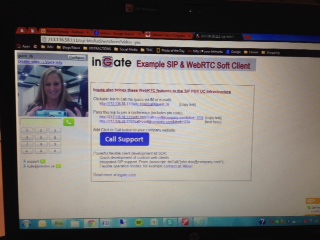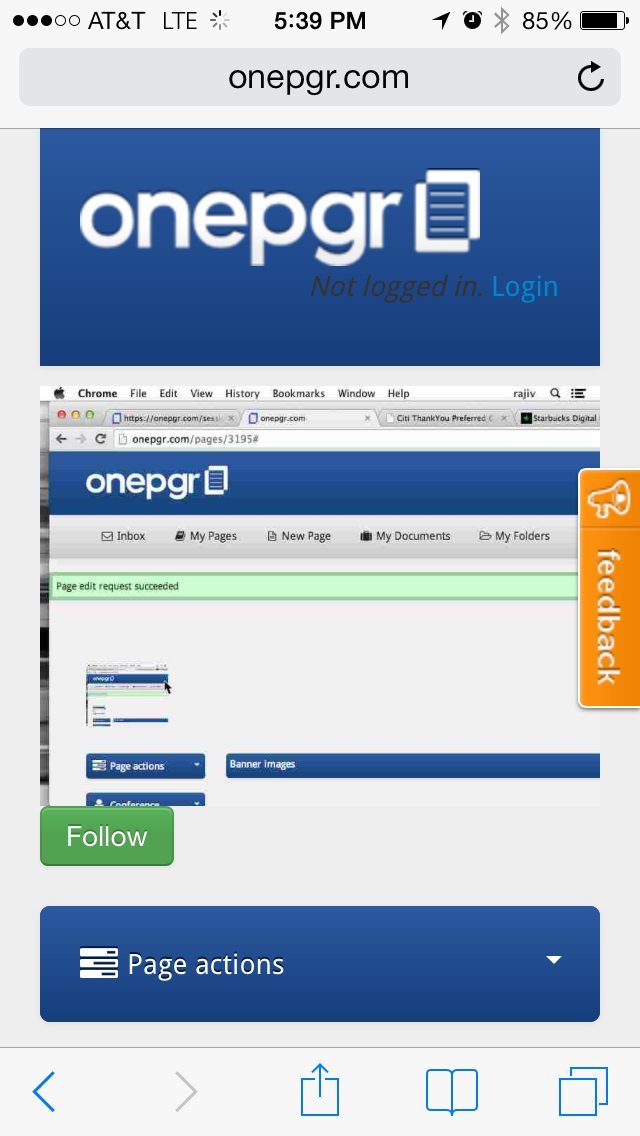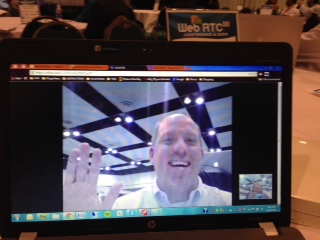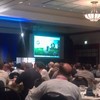Brent Kelly, Tsahi Levent-Levi, Victor Pascual Avila and Lawrence Byrd are the judges -- along with the audience, which will be responsible for entry into the finals.
---
Weemo, which develops APIs for real-time video communications to be embedded into applications, kicks off the demo. There was a quick shot towards the browsers that haven't yet supported WebRTC as the demo began. The demo created a very quick, one-button video communication between two parties.
Frankly, it seems like more of what we saw in the demos in Atlanta earlier this year.
---
Questionmine is not your typical webrtc company – we are a complementary product providing an interim step to enabling video in the contact center. Essentially, it provides a video IVR, helping reduce costs for sales teams, support teams, and leverage the power of video in customer service.
He filmed a video at 3:00am – that’s a normal activity, right? The video included an impersonation of a jackrabbit lizard (again, quite normal), but really focused on the concept of providing specific information to customers to help them resolve their issues, keeping their attention because of the video interaction.
It also allows interactive polling, which helps sales and marketing teams target customers, and provides viewership data to allow deeper dives into customer patterns and effectiveness of video content. This data can be pumped into and leveraged by other enterprise systems.
---
Frozen Mountain (coolest name so far) has a peer to peer SDK called IceLink, born out of a video scripting project that led to a realization that there was a lack of product for enabling similar technologies from the ground up that support multiple platforms. The pieces are out there, but not a comprehensive solution.
There are so many acronyms in the developer world it will cause a headache -- their goal is to take the complexity of those acronyms out of building a real-time communications application. The cool thing is they have built their SDK for nearly any development platform.
The focus is really on making the development simple and quick -- about 4 steps in the demo before they were able to launch a live video communication. This includes the ability to repackage the application for multiple platforms, include Web browsers.
So what happens with the legacy browsers? Well, they also showed a straight UDP connection to connect to IE as well. Basically, they have created a comprehensive framework that works across devices, platforms, and browsers in about 100 lines of code.
---
Karl Stahl from Ingate is next up, talking about Ingate's E-SBC products, which have integrated support for WebRTC. He provided an a IP address for users with Chrome-enabled devices to connect with him via WebRTC.
Karl is a visionary with the idea that we must turn the Internet into a communications tool, taking the risk and complexity out of multiple devices, platforms, browsers, codecs, etc. The point is that WebRTC is merely another category of endpoint, and not all communications will be WebRTC-to-WebRTC, so WebRTC has the be enabled to communicate with other platforms, which is where SBCs will play a critical role.
TMC's Rachel Ramsey called Karl -- this is the interface she saw.
---
AnyMeeting has about .5 million registered users, with its Chrome users leveraging WebRTC for audio already. They are all about making communications and collaboration simple -- especially screen sharing, which they say is the killer collaboration app.
Users download a small plugin to join the screensharing session -- dumb, simple screensharing, as they noted. But truthfully, it has to be simple in order for is to gain popularity, which is achieves.
The next iteration will add audio as well.
---
Vidyo provides a Web-based audio, video, content sharing platform -- it's the back-end infrastructure for the video collaboration for applications with embedded collaboration capabilities. It pulls together multiple video technologies from H.264, WebRTC, and others, effectively extending collaboration to not only multiple video technologies, but also non-WebRTC enabled browsers.
Its demo consisted of passing a tablet around the room -- we haven't actually seen it yet.
---
onepgr is a simple collaboration platform (I'm starting to see a common theme here) to make collaboration so easy that people can do their jobs without having to worry about the tech. The goal is a zero-install, zero-touch video conferencing platform.
It enables dragging and dropping files from local storage or other cloud-based storage apps like dropbox. Its current solution leverages TokBox technology for the WebRTC interactions. They also leverage Twilio for a cloud-based telephony platform.
He invited the audience to participate -- Rachel was again quick to volunteer, and received a text link to a screensharing session. That, of course, is the whole idea behind WebRTC, a simple way to initiate and join multimedia conversations.
After a slight delay to get the application to work, Rachel was able to see the shared screen real estate.
---
vLine started by explaining the v in vLine is for video...
It is a full-stack WebRTC platform that enables the creation of simple video conferencing applications. The connection was easy enough, but the real magic in the demo was the simple ability for Rachel (yes, trying it out again) to send me a link to join a video chat with her after initiating it with at most two steps. Pretty simple. Here I am waving to Rachel.
---
PubNub is up now and started by noting the millions and millions of dollars (not The Rock's fans) major social and enterprise applications have spend on providing real-time communications to their users.
PubNub introduced and open source WebRTC framework that enables Web-based communications without spinning up a host of signaling servers, using the data channel -- all with about 44 lines of code.
Overall, the company enables the addition of various kinds of real-time capabilities into applications, from collaboration to gaming to group chat to M2M and much more.
---
bistri started by asking how many attendees regularly use Skype, Google Hangouts, or Facetime -- surprisingly, the response was lower than one might have expected. Bsitri calls itself the Swiss Army knife of communications, providing unique URLs to each user allowing them to connect with any other users, regardless of device or browser.
It was hard to tell what exactly was taking place -- there was little explanation -- but eventually, it appeared they were able to connect three of four people into a multiparty conference environment (including their Paris office, its booth at WebRTC Expo, the audience, and themselves on stage.
The cool part of the bistri demo was using the app to call Google Glass, showing WeRTC running on Glass.
They call it a frictionless video experience, taking the complexity out of creating or joining a video call. WebRTC and Glass -- now that's a cool use case.
---
OpenClove took the stage, showing a WebRTC-based video interaction in a behavioral environment. In this case, the demo used a shopping experience combined with social networking to allow users to bring their friends and family into their shopping experiences.
You guessed it, Rachel sent a link. It worked, but wasn't as intuitive as some of the other demos (I had to click twice to initiate the video, once on her link and then on the Shop With Friends link on the page), and opened the video in a separate window instead of being embedded into the page.
The truth is, that the use case and not the technology, but it took away from the demo. This has potential, though.
---
Agnity combined Unified Communications with enterprise mobility. Now here's a topic right out of the ITEXPO playbook. They are looking to combine communications with business processes, and to allow communication and collaboration in context to drive new vertical business models.
Again, the demo took some time to set up. It uses a telehealth example to connect one physician to another for consulting on a patient. The demo wasn't overly clear, but in some capacity, the contextual patient information is carried between parties and communications mediums to enable collaboration regarding the patient.
---
Requestec won the Ready Now award at WebRTC Atlanta. Since then, it has added a variety of collaboration features based on customer request, allowing the capability to be embedded directly into customer Websites. Believe it or not, the demo will show real-time communication between browsers, enterprise communications platforms, and even PSTN users.
The example discussed a distance learning or training opportunity, where students would only have audio capabilities with one another, but the instructor sees their video feeds. Medtronic has already leveraged the solution to teach customers to use new medical equipment. They also have customers in the banking industry.
He claims to have achieved the smoothest video calls between US and China, largely thanks to the gateway's support of dynamic FEC.
---
Apex Voice Communications is a 20+ year communications service delivery platform vendor. Its platform consists of the OmniVox 3D app server, a media server, and service creation platform.
The demo is about a carrier cloud conferencing system for telecom operators that requires no network edge transcoding and interacts with existing network infrastructure, a key for telcos today, who aren't in a position to discard exiting investments.
The fun part of the demo was when they started talking about social video conferencing, allowing family and friends to share real-time experiences, not just time-delayed photos and videos. The interface and customizable content in different-sized tiles provided a very modern appearance.
----
AddLive claims to have been working with WebRTC technology before it was known as WebRTC, from the GIPS days. It is a cloud-based service designed to deliver high-quality video, already deploye to more than 5,000 businesses and 250k users via its customers' applications.
Tonight it is announcing v3 of its platform. One of the keys is interop between Chrome and Firefox browsers.
The demo is connecting WebRTC (native Chrome), IE, an iOS app, and an Android app, leveraging each of the SDKs it uses. The final step is to add Google Glass, which is accomplished seamlessly as well. Not surprisingly, Google Glass connectivity has received the loudest applause from the audience in the two instances it has been demoed this far.
---
NGMedia is showing its media server, with a WebRTC client connecting to a media server application to enable recording and switching between multiple live or recorded streams.
Use cases include contact centers being able to leverage it to create a video session with video IVR or informational video while on hold, then switching to a live stream as escalation or queue.
---
And that's a wrap. Now we're waiting for the judges to vote, along with the audience, to find out who will make it to tomorrow night's demos.
(queue Jeopardy music...)
---
And the entries making into tomorrow's finals are:
Audience choice: Weemo
Judges entries: vLine, Requestec, AddLive
Congratulations, we'll see you here tomorrow for the finals!













Leave a comment